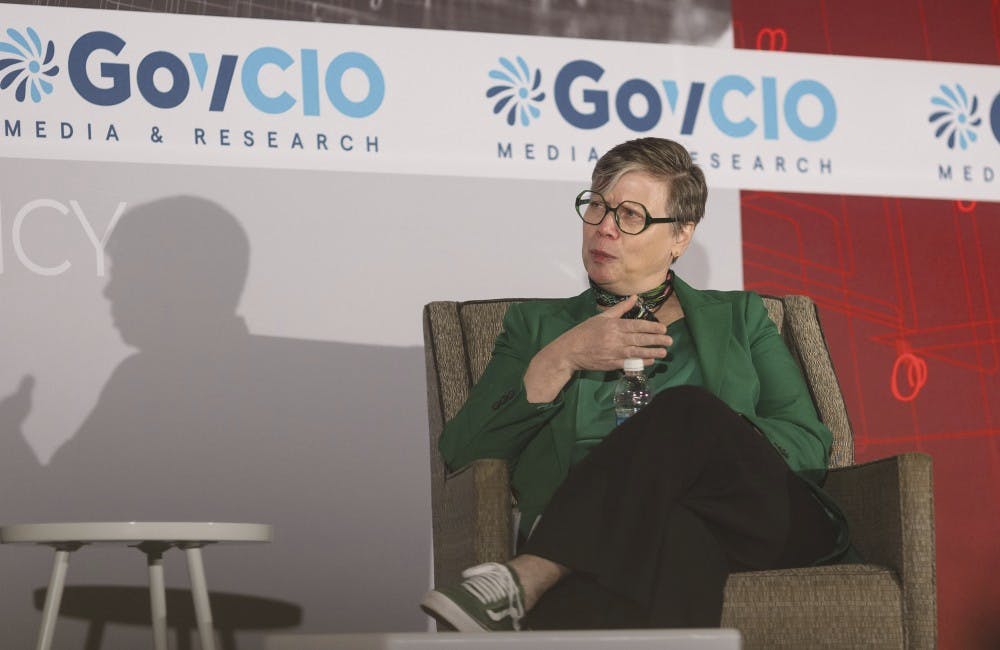USPTO, HRSA CIOs Look to Expand Remote Work, Mobility
The pandemic has prompted some agencies to shift long-term work policies and capabilities.

Federal agencies like the U.S. Patent and Trademark Office (USPTO) and the Health Resources and Services Administration (HRSA) were well-prepared for the mass transition to telework before the coronavirus pandemic due to prior IT investments and want to continue expanding those capabilities.
”Before the crisis, we were actually averaging about 8,000 teleworkers out of 13,000 workers,” said Jamie Holcombe, USPTO CIO, during the Future of Work virtual event Wednesday. “When the crisis hit, we were asked to go to maximum telework, and what we did was we pretty much doubled our [network] infrastructure.”
Along with contractors, USPTO has been supporting over 14,000 VPN connections every day since the shift, using collaborative video conferencing services such as Webex, Skype and Microsoft Teams.
“We have over 1,200 daily Webex meetings, with anywhere between 14 and 42 people per call. It’s an amazing thing,” noted Holcombe, whose agency’s sole mission is to award patents and register trademarks, including inventions related to the COVID-19 response.
Similarly, HRSA also made a smooth transition to maximum telework thanks to robust technologies in place.
“When you’re facing a contingency such as this, you need to make sure that your team is already ready to go. You can’t wait until there is an emergency to prepare for an emergency,” HRSA CIO Adriane Burton said.
With a significant portion of HRSA working remotely before the pandemic, the agency has adjusted well and has been using teleconferencing services like Skype frequently, Burton noted. The agency has also prepared its workforce with the necessary equipment and IT services training — such as video tutorials, FAQ pages and a “checklist” of support numbers to contact — but has also kept a minimum number of IT support staff on site to resolve hardware challenges.
HRSA has been the lead on ensuring rural area hospitals and health care providers that support millions of people who are economically and medically vulnerable in the fight against COVID-19 received grants through the Coronavirus Aid, Relief, and Economic Security (CARES) Act. In addition to receiving approximately $10 billion in annual funding for its grantee population, HRSA received $175 billion dollars to manage through the HHS COVID-19 Provider Relief Fund.
The agency’s top priority has been to issue those funds quickly and efficiently.
“Typically, 90 to 120 days is the normal grant lifecycle process at HRSA, but we were pushing out money in 18 days, and that was a heavy lift. People were working throughout the weekend to push those grants out, and then we went to 12 days because each time we got better and better,” Burton said, further noting that the agency was able to then reduce that time down to five days with the help of automated tools and processes.
As a result of the pandemic, HRSA is looking more into artificial intelligence and predictive analytics to support grants processes, Burton explained, and has been investing in platform-as-a-service (PaaS) solutions rather than custom applications.
Moving forward, the agencies are shifting their telework policies, with HRSA moving to 100% telework and USPTO following similar moves.
”We’ve just got the approval, and there’s a lot of work going to have our ability to telework anywhere in the United States,” Holcombe said. “You do not need to be in Alexandria, Virginia, to work at the USPTO — you can live anywhere, you can do almost anything, as long as you can get that high-speed internet connection. We will securely make sure you can do your job from anywhere.”
Additionally, the future of federal work after COVID-19 may center around increased mobility due to technological advancements and capabilities built on past progress.
“The [internet of things] and the device standards coming are going to be very key,” Holcombe explained. “I think we’re just at the third phase of the internet — the first phase was getting done with infrastructure, the next phase was the killer app, and the final phase is going to be the whole IOT and being able to address everything. Work will never be the same. And I think COVID-19 became the catalyst to make IOT happen even quicker with 5G.”
“And don’t forget about security,” Burton added.
This is a carousel with manually rotating slides. Use Next and Previous buttons to navigate or jump to a slide with the slide dots
-

Navy Lab's PROTEUS Provides AI-Powered Maritime Awareness
NRL's Alan Hope details how real-time data and AI are empowering agencies to track vessels, combat threats and enhance maritime domain awareness.
23m watch -

NCI Uses Wearables Data to Link Exercise to Cancer Risk
NCI finds a connection between low-intensity exercise and decreased risk of cancer through data collected from wearable technology.
9m listen -

Navy Software Optimization Journey Focuses on Efficiency
DOD and DOGE collaborate on initiative to cut waste and improve technology acquisition, DON deputy CIO says.
4m read -

AI Boosts Customer Experience at Federal Contact Centers
Federal contact center leaders at DOL and VA are exploring AI's potential to drive efficiency and boost customer experience.
3m read








